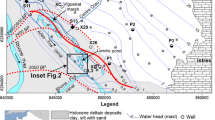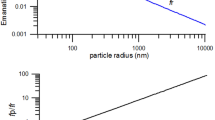Abstract
The recently developed natural radon tracer method has potential as a rapid, low‐cost, nondestructive, and noninvasive method for quantifying NAPL contamination. In the subsurface, radon‐222 (radon) is produced by the decay of naturally occurring radium‐226 contained in the mineral fraction of aquifer solids. In groundwater radon occurs as a dissolved gas, with a half‐life of 3.83 days. In the absence of NAPL, the radon concentration in groundwater quickly reaches a maximum value that is determined by the mineral composition of the aquifer solids, which controls the rate of radon emanation. In the presence of NAPL, however, the radon concentration in the groundwater is substantially reduced due to the preferential partitioning of radon into the organic NAPL phase. A simple equilibrium model and supporting laboratory studies show the reduction in radon concentration can be quantitatively correlated with residual NAPL saturation. Thus, by measuring the spatial distribution in radon it may be possible to identify locations where residual NAPL is present and to quantify the NAPL saturation. When the basic processes of partitioning, radon emanation from the aquifer solids, and first‐order decay are incorporated into an advective/dispersive transport model, good agreement is obtained with the results of laboratory and field experiments. Model sensitivity analyses shows many factors can contribute to the radon concentration response, including the length of the NAPL zone, NAPL saturation, groundwater velocity, porosity, and radon emanation. Thus, care must be taken when applying the radon method to locate and quantify NAPL contamination in the subsurface.
Similar content being viewed by others
References
Andrews, J. N. and Wood, D. F.: 1972, Mechanisms of radon release in rock matrices and entry into groundwater, Inst. Mining and Metallurgy Trans. 81, B198–B209.
Clements, E. W. and Wilkening, M. H.: 1974, Atmospheric pressure effects on radon-222 transport across the earth-air interface, J. Geophys. Res. 79(33), 5025–5029.
Clever, L. H. (ed.): 1979, Krypton, Xenon, and Radon-Gas Solubilities, Solubility Data Series 2, Vol. 18, Pergamon, New York.
Cohen, R. M. and Mercer, J.W.: 1993, DNAPL Site Evaluation, CRC Press, Boca Raton, Florida.
Environmental Protection Agency: 1992, Dense nonaqueous phase liquids: a workshop summary, In: Dense Nonaqueous Phase Liquids, Dallas, Texas, EPA, p. 81.
Feenstra, S.: 1997, Aqueous concentration ratios to estimate mass of multi-component NAPL residual in porous media, PhD Thesis, Department of Earth Sciences, University of Waterloo, Ontario, Canada.
Feenstra, S. and Cherry, J. A.: 1998, Aqueous concentration ratios to estimate mass of multicomponent NAPL residual, In: G. B. Wickramamayake and R. E. Hinchee (eds), Nonaqueous-Phase Liquids: Remediation of Recalcitrant Compounds, Battelle Press, Columbus, OH, pp. 55–60.
Fleischer, R. L.: 1983, Theory of alpha recoil effects on radon release and isotopic disequilibrium, Geochim. Cosmochim. Acta 47, 779–784.
Jin, M., Buler, R. E., Jackson, R. E., Mariner, P. E., Pickens, J. F., Pope, G. A., Brown, C. L. and McKinney, D. C.: 1997, Sensitivity models design and protocol for partitioning tracers in alluvial aquifers, Ground Water 35(6), 964–972.
Jin, M., Delshad, M., Dwarakanath, V., McKinney, D. C., Pope, G. A., Sepehroori, K. and Tilburg, C. E.: 1995, Partitioning tracer test for detection, estimation, and monitoring the remediation performance assessment of subsurface nonaqueous phase liquids, Water Resour. Res. 31(5), 1201–1211.
Van Genuchten, M.: 1981, Analytical solutions for chemical transport with simultaneous adsorption, zero-order production, and first-order decay, J. Hydrol. 49, 213–233.
Hunkeler, D., Hoehn, E., Hohener, P. and Zeyer, J.: 1997, 222Rn as a partitioning tracer to detect diesel fuel contamination in aquifer: laboratory study and field observations, Environ. Sci. Technol. 31(11), 3180–3187.
Hopkins, O. S.: 1994, Radon-222 as an indicator for nonaqueous phase liquids in the saturated zone: developing a detection technology, Master's Thesis, Oregon State University.
Looney, B. B, Jerome, K. M. and Davey, C.: 1998, Single-well DNAPL characterization using alcohol injection/extraction, In: G. B. Wickramamayake and R. E. Hinchee (eds), Nonaqueous-Phase Liquids: Remediation of Recalcitrant Compounds, Battelle Press, Columbus, OH, pp. 55–60.
Lucas, H. F.: 1964, A fast and accurate survey technique for both 222Rn and 226Ra, In: J. A. S. Adams and W. M. Lowder (eds), The Natural Radiation Environment, Chicago, Illinois, University of Chicago Press, p. 315.
McBride, J. F., Simmons, C. S. and Cary, J. W.: 1992, Interfacial spreading effects on one-dimensional organic imbibition in water-wetted porous media, J. Contam. Hydrol. 11, 1–25.
Mercer, J. and Cohen, R.: 1990, A review of immiscible fluids in the subsurface, J. Contam. Hydrol. 6, 107–163.
Nelson, N. T. and Brusseau, M. L.: 1996, Field study of partitioning tracer method for detection of dense nonaqueous phase liquid in a trichloroethene-contaminated aquifer, Eviron. Sci. Technol. 30(9), 2859–2863.
Rivett, M. O.: 1995, Soil gas signatures from volatile chlorinated solvents: Borden Field experiments, Ground Water 33(1), 84–98.
Semprini, L., Broholm, K. and McDonald, M.: 1993, Radon-222 deficit method for locating and quantifying NAPL contamination in the subsurface, EOS Trans. American Geophys. Union 74(43), 299.
Semprini, L., Hopkins, O. S., Gottipati, S. and Tasker, B. R.: 1995, Field, laboratory and, modeling studies of radon-222 as a natural tracer for detecting NAPL contamination in the subsurface and monitoring the progress of remediation, EOS Trans. American Geophys. Union 76(46), F276.
Semprini, L., Cantaloub, M., Gottipati, S., Hopkins, O. and Istok, J.: 1998, Radon-222 as a tracer for quantifying and monitoring NAPL remediation, In: G. B. Wickramamayake and R. E. Hinchee (eds), Nonaqueous-Phase Liquids: Remediation of Recalcitrant Compounds, Battelle Press, Columbus, OH, pp. 137–142.
Tanner, A. B.: 1978, Radon migration in the ground: a supplementary review. In: T. Gessel and W. Lowder (eds), The Natural Radiation Environment III, Department of Energy, Oak Ridge, TN, pp. 5–56.
Tasker, B. R.: 1995, Radon-222 as an indicator for a nonaqueous phase liquids in the saturated zone: a numerical methods analysis, Engineering Report, MS Degree, Department of Civil Engineering, Oregon State University.
Thamer, B. J., Nielson, K. K. and Felthauser, K.: 1982, The effect of moisture on radon emanation including the effects of diffusion, Bureau of Mines Open File Report No. 184-84.
Author information
Authors and Affiliations
Rights and permissions
About this article
Cite this article
Semprini, L., Hopkins, O.S. & Tasker, B.R. Laboratory, Field and Modeling Studies of Radon‐222 as a Natural Tracer for Monitoring NAPL Contamination. Transport in Porous Media 38, 223–240 (2000). https://doi.org/10.1023/A:1006671519143
Issue Date:
DOI: https://doi.org/10.1023/A:1006671519143




